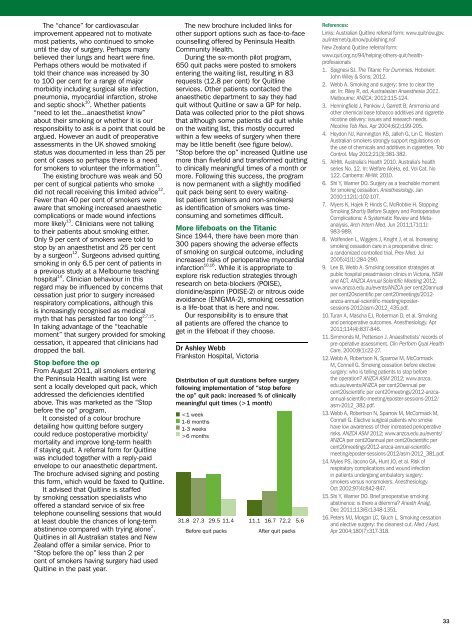ANZCA Bulletin June 2012 - final.pdf - Australian and New Zealand ...
ANZCA Bulletin June 2012 - final.pdf - Australian and New Zealand ...
ANZCA Bulletin June 2012 - final.pdf - Australian and New Zealand ...
- No tags were found...
You also want an ePaper? Increase the reach of your titles
YUMPU automatically turns print PDFs into web optimized ePapers that Google loves.
The “chance” for cardiovascularimprovement appeared not to motivatemost patients, who continued to smokeuntil the day of surgery. Perhaps manybelieved their lungs <strong>and</strong> heart were fine.Perhaps others would be motivated iftold their chance was increased by 30to 100 per cent for a range of majormorbidity including surgical site infection,pneumonia, myocardial infarction, stroke<strong>and</strong> septic shock 10 . Whether patients“need to let the...anaesthetist know”about their smoking or whether it is ourresponsibility to ask is a point that could beargued. However an audit of preoperativeassessments in the UK showed smokingstatus was documented in less than 25 percent of cases so perhaps there is a needfor smokers to volunteer the information 11 .The existing brochure was weak <strong>and</strong> 50per cent of surgical patients who smokedid not recall receiving this limited advice 12 .Fewer than 40 per cent of smokers wereaware that smoking increased anaestheticcomplications or made wound infectionsmore likely 13 . Clinicians were not talkingto their patients about smoking either.Only 9 per cent of smokers were told tostop by an anaesthetist <strong>and</strong> 25 per centby a surgeon 12 . Surgeons advised quittingsmoking in only 6.5 per cent of patients ina previous study at a Melbourne teachinghospital 14 . Clinician behaviour in thisregard may be influenced by concerns thatcessation just prior to surgery increasedrespiratory complications, although thisis increasingly recognised as medicalmyth that has persisted far too long 2,7,15 .In taking advantage of the “teachablemoment” that surgery provided for smokingcessation, it appeared that clinicians haddropped the ball.Stop before the opFrom August 2011, all smokers enteringthe Peninsula Health waiting list weresent a locally developed quit pack, whichaddressed the deficiencies identifiedabove. This was marketed as the “Stopbefore the op” program.It consisted of a colour brochuredetailing how quitting before surgerycould reduce postoperative morbidity/mortality <strong>and</strong> improve long-term healthif staying quit. A referral form for Quitlinewas included together with a reply-paidenvelope to our anaesthetic department.The brochure advised signing <strong>and</strong> postingthis form, which would be faxed to Quitline.It advised that Quitline is staffedby smoking cessation specialists whooffered a st<strong>and</strong>ard service of six freetelephone counselling sessions that wouldat least double the chances of long-termabstinence compared with trying alone 2 .Quitlines in all <strong>Australian</strong> states <strong>and</strong> <strong>New</strong>Zeal<strong>and</strong> offer a similar service. Prior to“Stop before the op” less than 2 percent of smokers having surgery had usedQuitline in the past year.The new brochure included links forother support options such as face-to-facecounselling offered by Peninsula HealthCommunity Health.During the six-month pilot program,650 quit packs were posted to smokersentering the waiting list, resulting in 83requests (12.8 per cent) for Quitlineservices. Other patients contacted theanaesthetic department to say they hadquit without Quitline or saw a GP for help.Data was collected prior to the pilot showsthat although some patients did quit whileon the waiting list, this mostly occurredwithin a few weeks of surgery when theremay be little benefit (see figure below).“Stop before the op” increased Quitline usemore than fivefold <strong>and</strong> transformed quittingto clinically meaningful times of a month ormore. Following this success, the programis now permanent with a slightly modifiedquit pack being sent to every waitinglistpatient (smokers <strong>and</strong> non-smokers)as identification of smokers was timeconsuming<strong>and</strong> sometimes difficult.More lifeboats on the TitanicSince 1944, there have been more than300 papers showing the adverse effectsof smoking on surgical outcome, includingincreased risks of perioperative myocardialinfarction 10,16 . While it is appropriate toexplore risk reduction strategies throughresearch on beta-blockers (POISE),clonidine/aspirin (POISE-2) or nitrous oxideavoidance (ENIGMA-2), smoking cessationis a life-boat that is here <strong>and</strong> now.Our responsibility is to ensure thatall patients are offered the chance toget in the lifeboat if they choose.Dr Ashley WebbFrankston Hospital, VictoriaDistribution of quit durations before surgeryfollowing implementation of “stop beforethe op” quit pack: increased % of clinicallymeaningful quit times (>1 month)6 months31.8 27.3 29.5 11.4 11.1 16.7 72.2 5.6Before quit packsAfter quit packsReferences:Links: <strong>Australian</strong> Quitline referral form: www.quitnow.gov.au/internet/quitnow/publishing.nsf<strong>New</strong> Zeal<strong>and</strong> Quitline referral form:www.quit.org.nz/94/helping-others-quit/healthprofessionals1. Spignesi SJ. The Titanic For Dummies. Hoboken:John Wiley & Sons; <strong>2012</strong>.2. Webb A. Smoking <strong>and</strong> surgery: time to clear theair. In: Riley R, ed. Australasian Anaesthesia 2011.Melbourne: <strong>ANZCA</strong>; <strong>2012</strong>:115-124.3. Henningfield J, Pankow J, Garrett B. Ammonia <strong>and</strong>other chemical base tobacco additives <strong>and</strong> cigarettenicotine delivery: issues <strong>and</strong> research needs.Nicotine Tob Res. Apr 2004;6(2):199-205.4. Heydon NJ, Kennington KS, Jalleh G, Lin C. Western<strong>Australian</strong> smokers strongly support regulations onthe use of chemicals <strong>and</strong> additives in cigarettes. TobControl. May <strong>2012</strong>;21(3):381-382.5. AIHW. Australia’s Health 2010. Australia’s healthseries No. 12. In: Welfare AIoHa, ed. Vol Cat. No122. Canberra: AIHW; 2010.6. Shi Y, Warner DO. Surgery as a teachable momentfor smoking cessation. Anesthesiology. Jan2010;112(1):102-107.7. Myers K, Hajek P, Hinds C, McRobbie H. StoppingSmoking Shortly Before Surgery <strong>and</strong> PostoperativeComplications: A Systematic Review <strong>and</strong> Metaanalysis.Arch Intern Med. Jun 2011;171(11):983-989.8. Wolfenden L, Wiggers J, Knight J, et al. Increasingsmoking cessation care in a preoperative clinic:a r<strong>and</strong>omized controlled trial. Prev Med. Jul2005;41(1):284-290.9. Lee B, Webb A. Smoking cessation strategies atpublic hospital preadmission clinics in Victoria, NSW<strong>and</strong> ACT. <strong>ANZCA</strong> Annual Scientific Meeting <strong>2012</strong>;www.anzca.edu.au/events/<strong>ANZCA</strong> per cent20annualper cent20scientific per cent20meetings/<strong>2012</strong>-anzca-annual-scientific-meeting/epostersessions-<strong>2012</strong>/asm-<strong>2012</strong>_435.<strong>pdf</strong>.10. Turan A, Mascha EJ, Roberman D, et al. Smoking<strong>and</strong> perioperative outcomes. Anesthesiology. Apr2011;114(4):837-846.11. Simmonds M, Petterson J. Anaesthetists’ records ofpre-operative assessment. Clin Perform Qual HealthCare. 2000;8(1):22-27.12. Webb A, Robertson N, Sparrow M, McCormackM, Connell G. Smoking cessation before electivesurgery: who is telling patients to stop beforethe operation? <strong>ANZCA</strong> ASM <strong>2012</strong>; www.anzca.edu.au/events/<strong>ANZCA</strong> per cent20annual percent20scientific per cent20meetings/<strong>2012</strong>-anzcaannual-scientific-meeting/eposter-sessions-<strong>2012</strong>/asm-<strong>2012</strong>_382.<strong>pdf</strong>.13. Webb A, Robertson N, Sparrow M, McCormack M,Connell G. Elective surgical patients who smokehave low awareness of their increased perioperativerisks. <strong>ANZCA</strong> ASM <strong>2012</strong>; www.anzca.edu.au/events/<strong>ANZCA</strong> per cent20annual per cent20scientific percent20meetings/<strong>2012</strong>-anzca-annual-scientificmeeting/eposter-sessions-<strong>2012</strong>/asm-<strong>2012</strong>_381.<strong>pdf</strong>.14. Myles PS, Iacono GA, Hunt JO, et al. Risk ofrespiratory complications <strong>and</strong> wound infectionin patients undergoing ambulatory surgery:smokers versus nonsmokers. Anesthesiology.Oct 2002;97(4):842-847.15. Shi Y, Warner DO. Brief preoperative smokingabstinence: is there a dilemma? Anesth Analg.Dec 2011;113(6):1348-1351.16. Peters MJ, Morgan LC, Gluch L. Smoking cessation<strong>and</strong> elective surgery: the cleanest cut. Med J Aust.Apr 2004;180(7):317-318.33
















